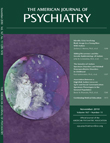Relief From Chronic Intractable Auditory Hallucinations After Long-Term Bilateral Theta Burst Stimulation
“Mr. C” was a 52-year-old right-handed man with a 22-year history of paranoid schizophrenia (consistent with DSM-IV criteria). The patient suffered from chronic, continuous, distressing voices that were resistant to different antipsychotics in correct doses for correct treatment periods as well as to cognitive behavioral therapy. Continuous theta burst stimulation was applied to the left and right temporoparietal cortex once per working day in the morning for 9 weeks (International 10-20 system for EEG electrode placement: between positions T3/P3 and T4/P4; 40 sec; three stimuli at 50 Hz every 200 msec; 80% active motor threshold). Treatment with clozapine (200 mg/ day) and amisulpride (600 mg/day) was continued. An EEG obtained before treatment showed clozapine-induced changes but no epilepsy typical signs. No side effects were noted. Auditory hallucinations were evaluated using the subjective Hallucination Chan ge Scale, quantifying the change of hallucinations around the baseline score of 10 from 0 to 20 (1). In the first week of treatment, the patient reported a suppression of auditory hallucinations for several minutes immediately after each stimulation (Hallucination Change Scale score: 9). Subsequently, he described a reduction of loudness in the second week (Hallucination Change Scale score: 7); longer periods without auditory hallucinations in the fourth week (Hallucination Change Scale score: 5); rare hallucinations in the fifth week (Hallucination Change Scale score: 3); and lasting, complete suppression from the sixth week onward (Hallucination Change Scale score: 0). His score on the Positive and Negative Syndrome Scale decreased from 93 to 61 (positive subscale score: 27→11, negative subscale score: 25→22, general psychopathology subscale score: 41→28). His score on the Global Assessment of Functioning increased from 42 to 55. Weekly evaluation of hallucinations confirmed their continuous absence for 3 months.
Footnote
References
Information & Authors
Information
Published In
History
Authors
Funding Information
Metrics & Citations
Metrics
Citations
Export Citations
If you have the appropriate software installed, you can download article citation data to the citation manager of your choice. Simply select your manager software from the list below and click Download.
For more information or tips please see 'Downloading to a citation manager' in the Help menu.
View Options
View options
PDF/EPUB
View PDF/EPUBLogin options
Already a subscriber? Access your subscription through your login credentials or your institution for full access to this article.
Personal login Institutional Login Open Athens loginNot a subscriber?
PsychiatryOnline subscription options offer access to the DSM-5-TR® library, books, journals, CME, and patient resources. This all-in-one virtual library provides psychiatrists and mental health professionals with key resources for diagnosis, treatment, research, and professional development.
Need more help? PsychiatryOnline Customer Service may be reached by emailing [email protected] or by calling 800-368-5777 (in the U.S.) or 703-907-7322 (outside the U.S.).

